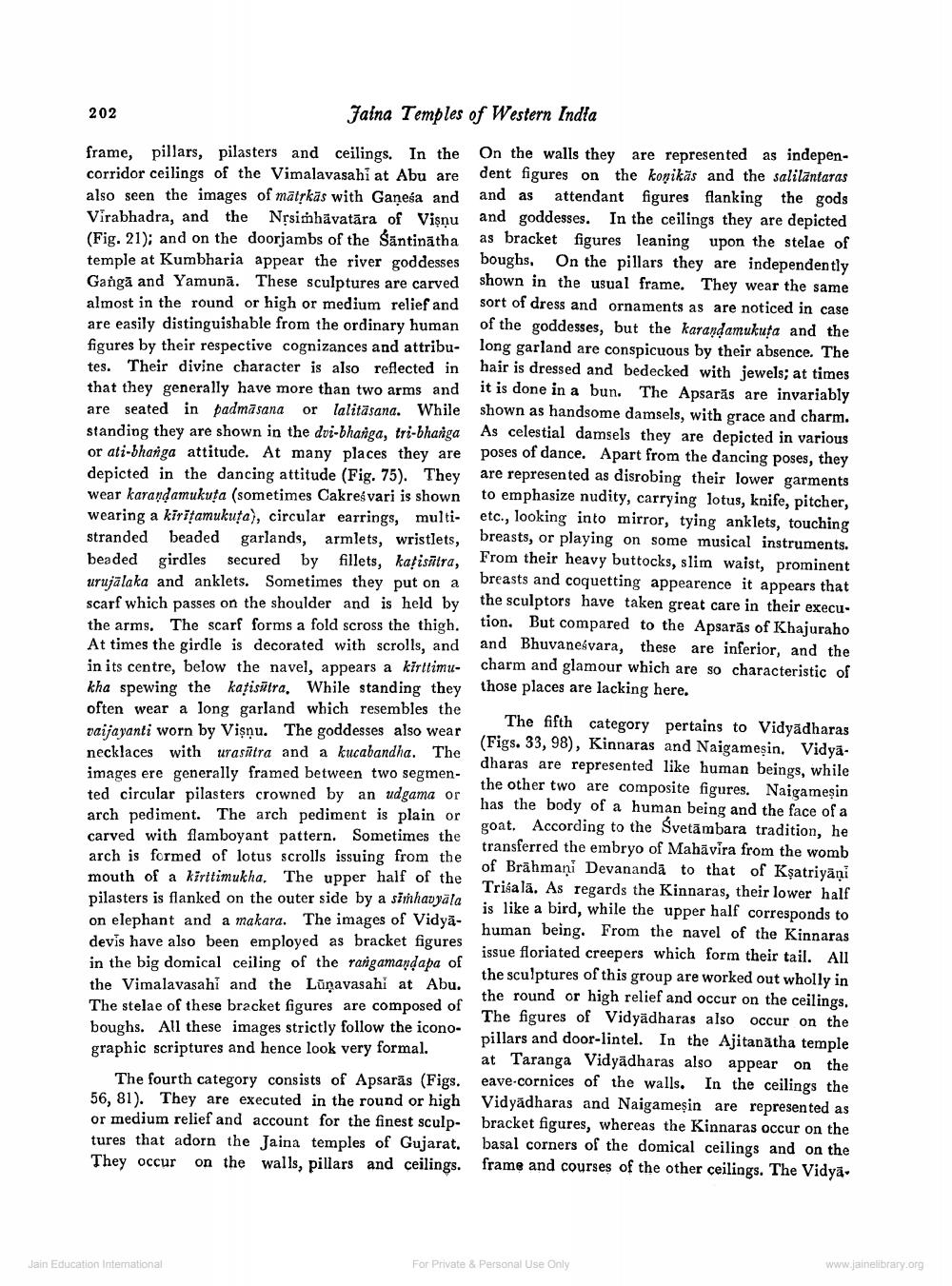________________
202
Faina Temples of Western Indła
frame, pillars, pilasters and ceilings. In the corridor ceilings of the Vimalavasahi at Abu are also seen the images of Mātrkas with Ganesa and Virabhadra, and the Nțsinhāvatāra of Vişnu (Fig. 21), and on the doorjambs of the Santinātha temple at Kumbharia appear the river goddesses Ganga and Yamunā. These sculptures are carved almost in the round or high or medium relief and are easily distinguishable from the ordinary human figures by their respective cognizances and attribu- tes. Their divine character is also reflected in that they generally have more than two arms and are seated in badmāsana or lalitäsana. While standing they are shown in the dvi-bhanga, tri-bhanga or ati.bhasiga attitude. At many places they are depicted in the dancing attitude (Fig. 75). They wear karaṇdamukuta (sometimes Cakreśvari is shown wearing a kiritamukuța), circular earrings, multi- stranded beaded garlands, armlets, wristlets, beaded girdles secured by fillets, katisitra, urujalaka and anklets. Sometimes they put on a scarf which passes on the shoulder and is held by the arms. The scarf forms a fold scross the thigh. At times the girdle is decorated with scrolls, and in its centre, below the navel, appears a kiritimu- kha spewing the katisätra. While standing they often wear a long garland which resembles the vaijayanti worn by Vişnu. The goddesses also wear necklaces with urasitra and a kucabandha. The images ere generally framed between two segmented circular pilasters crowned by an udgama or arch pediment. The arch pediment is plain or carved with flamboyant pattern. Sometimes the arch is formed of lotus scrolls issuing from the mouth of a kiritimukha. The upper half of the pilasters is flanked on the outer side by a sinhavyala on elephant and a makara. The images of Vidyadevis have also been employed as bracket figures in the big domical ceiling of the rargamaydapa of the Vimalavasahi and the Lünavasahi at Abu. The stelae of these bracket figures are composed of boughs. All these images strictly follow the iconographic scriptures and hence look very formal.
The fourth category consists of Apsarās (Figs. 56. 81). They are executed in the round or high or medium relief and account for the finest sculp- tures that adorn the Jaina temples of Gujarat. They occur on the walls, pillars and ceilings.
On the walls they are represented as independent figures on the koņikās and the salilantaras and as attendant figures flanking the gods and goddesses. In the ceilings they are depicted as bracket figures leaning upon the stelae of boughs, On the pillars they are independently shown in the usual frame. They wear the same sort of dress and ornaments as are noticed in case of the goddesses, but the karandamukuta and the long garland are conspicuous by their absence. The hair is dressed and bedecked with jewels; at times it is done in a bun. The Apsarās are invariably shown as handsome damsels, with grace and charm. As celestial damsels they are depicted in various poses of dance. Apart from the dancing poses, they are represented as disrobing their lower garments to emphasize nudity, carrying lotus, knife, pitcher, etc., looking into mirror, tying anklets, touching breasts, or playing on some musical instruments. From their heavy buttocks, slim waist, prominent breasts and coquetting appearence it appears that the sculptors have taken great care in their execution. But compared to the Apsarās of Khajuraho and Bhuvanesvara, these are inferior, and the charm and glamour which are so characteristic of those places are lacking here.
The fifth category pertains to Vidyadharas (Figs. 33, 98), Kinnaras and Naigameşin. Vidyā. dharas are represented like human beings, while the other two are composite figures. Naigameşin has the body of a human being and the face of a goat. According to the Svetämbara tradition, he transferred the embryo of Mahavira from the womb of Brähmani Devanandā to that of Ksatriyāņi Trisala. As regards the Kinnaras, their lower half is like a bird, while the upper half corresponds to human being. From the navel of the Kinnaras issue floriated creepers which form their tail. All the sculptures of this group are worked out wholly in the round or high relief and occur on the ceilings. The figures of Vidyadharas also occur on the pillars and door-lintel. In the Ajitanātha temple at Taranga Vidyadharas also appear on the eave-cornices of the walls. In the ceilings the Vidyadharas and Naigameşin are represented as bracket figures, whereas the Kinnaras occur on the basal corners of the domical ceilings and on the frame and courses of the other ceilings. The Vidyā.
For Private & Personal Use Only
www.ainelibrary.org
Jain Education International




